Analyzing Safety Breaches: The Uttar Pradesh Train Crash Incident
VerifiedAdded on 2023/06/07
|11
|2649
|315
Report
AI Summary
This report provides an in-depth analysis of the train crash that occurred in Uttar Pradesh, India, focusing on the Puri-Hardwar Express incident. It identifies the failure of railway staff and rail fracture as the primary causes, supported by evidence of persistent safety management issues within Indian Railways. The report highlights the increasing rate of train derailments since 2015 and details how issues like carelessness, non-alignment to safety rules, and inadequate maintenance contributed to the accident. Furthermore, it explores the impact of financial constraints on railway maintenance and modernization. The latter part of the report outlines the policy changes and new practices adopted by the Indian Railway department following the crash, including the incorporation of executive analysts for proactive safety audits, the phasing out of conventional ICF coaches for superfast trains, and the implementation of advanced technologies for detecting rail fractures and vibrations. The report concludes by emphasizing the shared responsibility of staff failure, rail fracture, and departmental shortcomings in causing the accident, while also noting the potential for improved safety through the implementation of these changes.
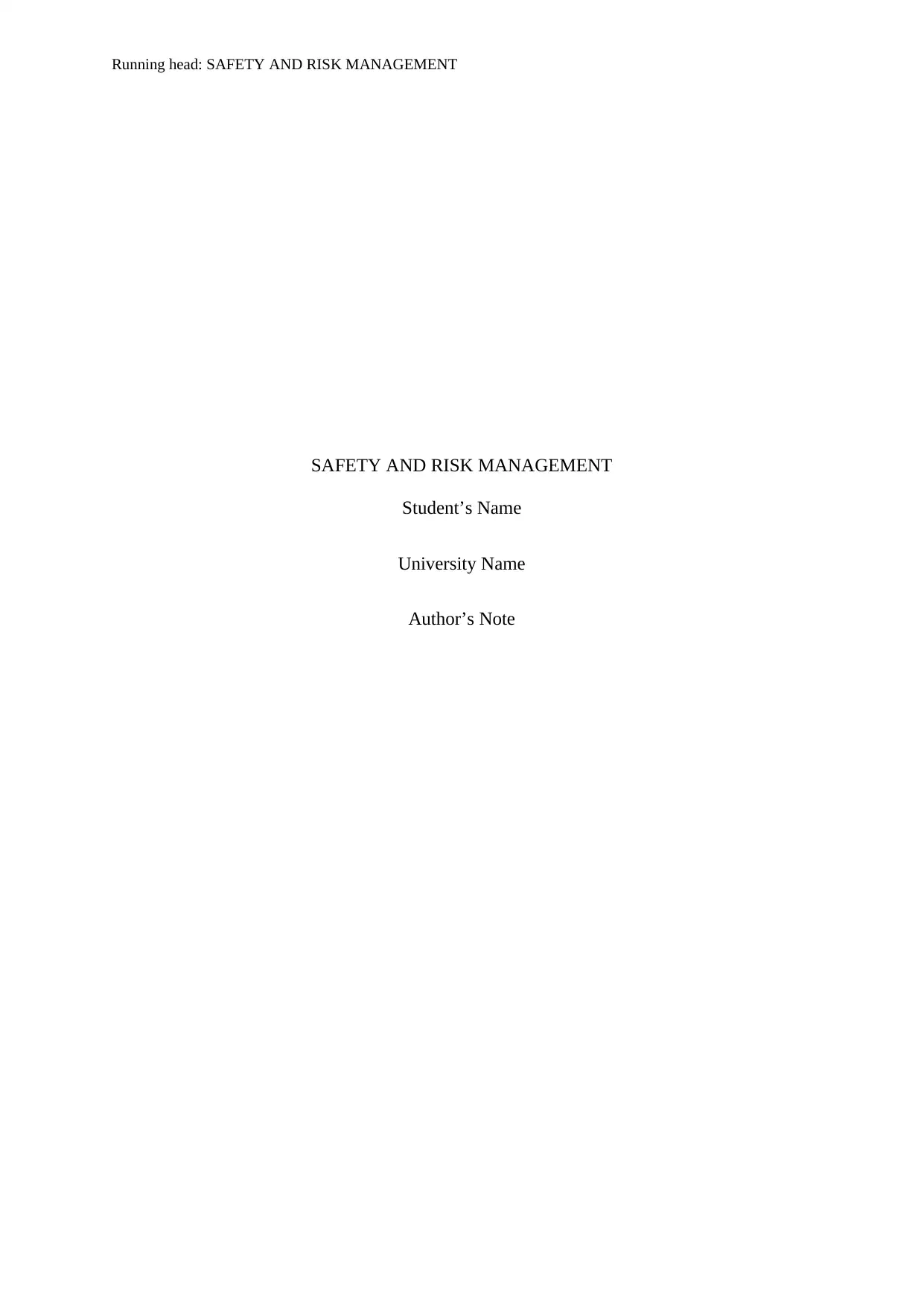
Running head: SAFETY AND RISK MANAGEMENT
SAFETY AND RISK MANAGEMENT
Student’s Name
University Name
Author’s Note
SAFETY AND RISK MANAGEMENT
Student’s Name
University Name
Author’s Note
Paraphrase This Document
Need a fresh take? Get an instant paraphrase of this document with our AI Paraphraser
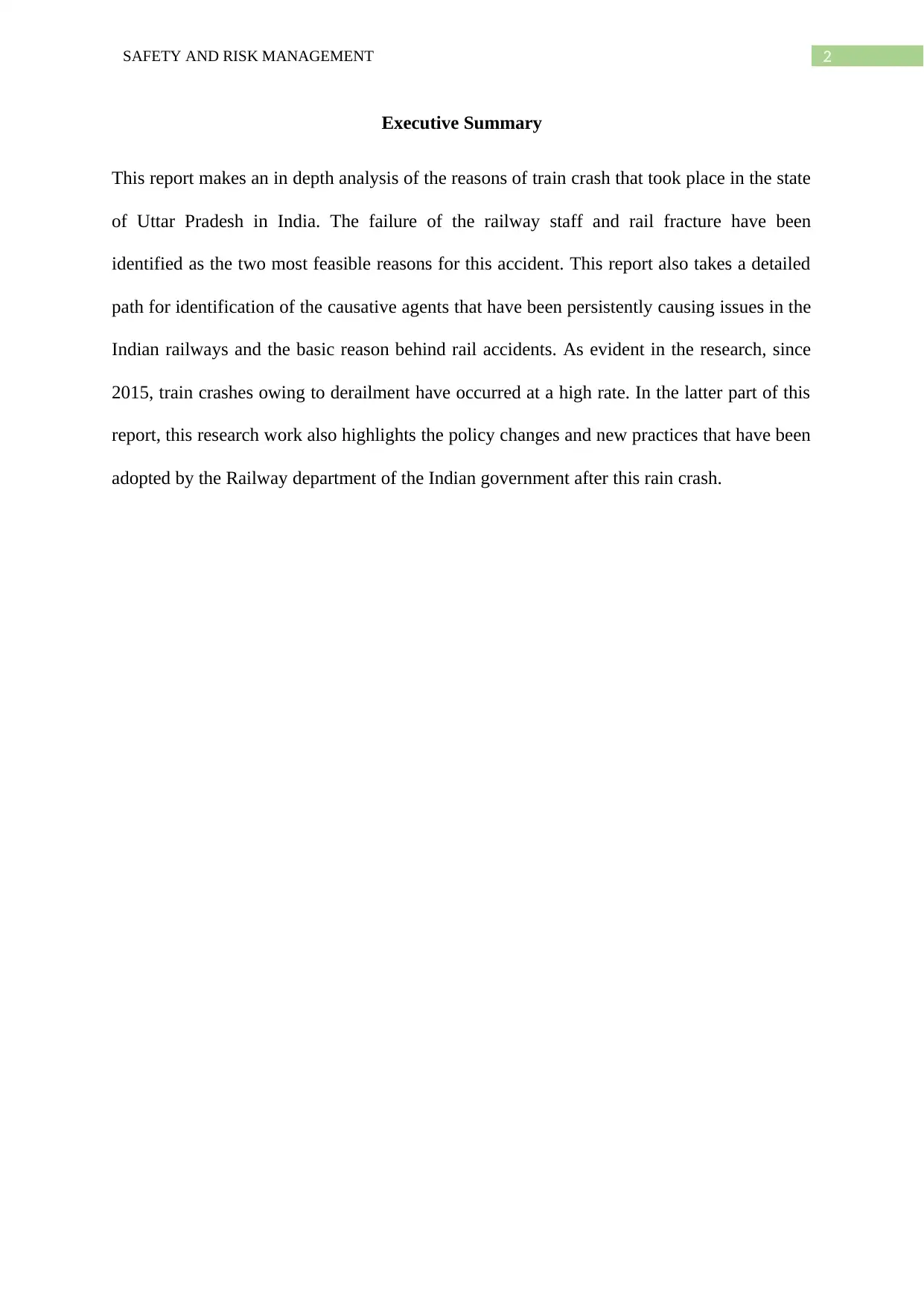
2SAFETY AND RISK MANAGEMENT
Executive Summary
This report makes an in depth analysis of the reasons of train crash that took place in the state
of Uttar Pradesh in India. The failure of the railway staff and rail fracture have been
identified as the two most feasible reasons for this accident. This report also takes a detailed
path for identification of the causative agents that have been persistently causing issues in the
Indian railways and the basic reason behind rail accidents. As evident in the research, since
2015, train crashes owing to derailment have occurred at a high rate. In the latter part of this
report, this research work also highlights the policy changes and new practices that have been
adopted by the Railway department of the Indian government after this rain crash.
Executive Summary
This report makes an in depth analysis of the reasons of train crash that took place in the state
of Uttar Pradesh in India. The failure of the railway staff and rail fracture have been
identified as the two most feasible reasons for this accident. This report also takes a detailed
path for identification of the causative agents that have been persistently causing issues in the
Indian railways and the basic reason behind rail accidents. As evident in the research, since
2015, train crashes owing to derailment have occurred at a high rate. In the latter part of this
report, this research work also highlights the policy changes and new practices that have been
adopted by the Railway department of the Indian government after this rain crash.
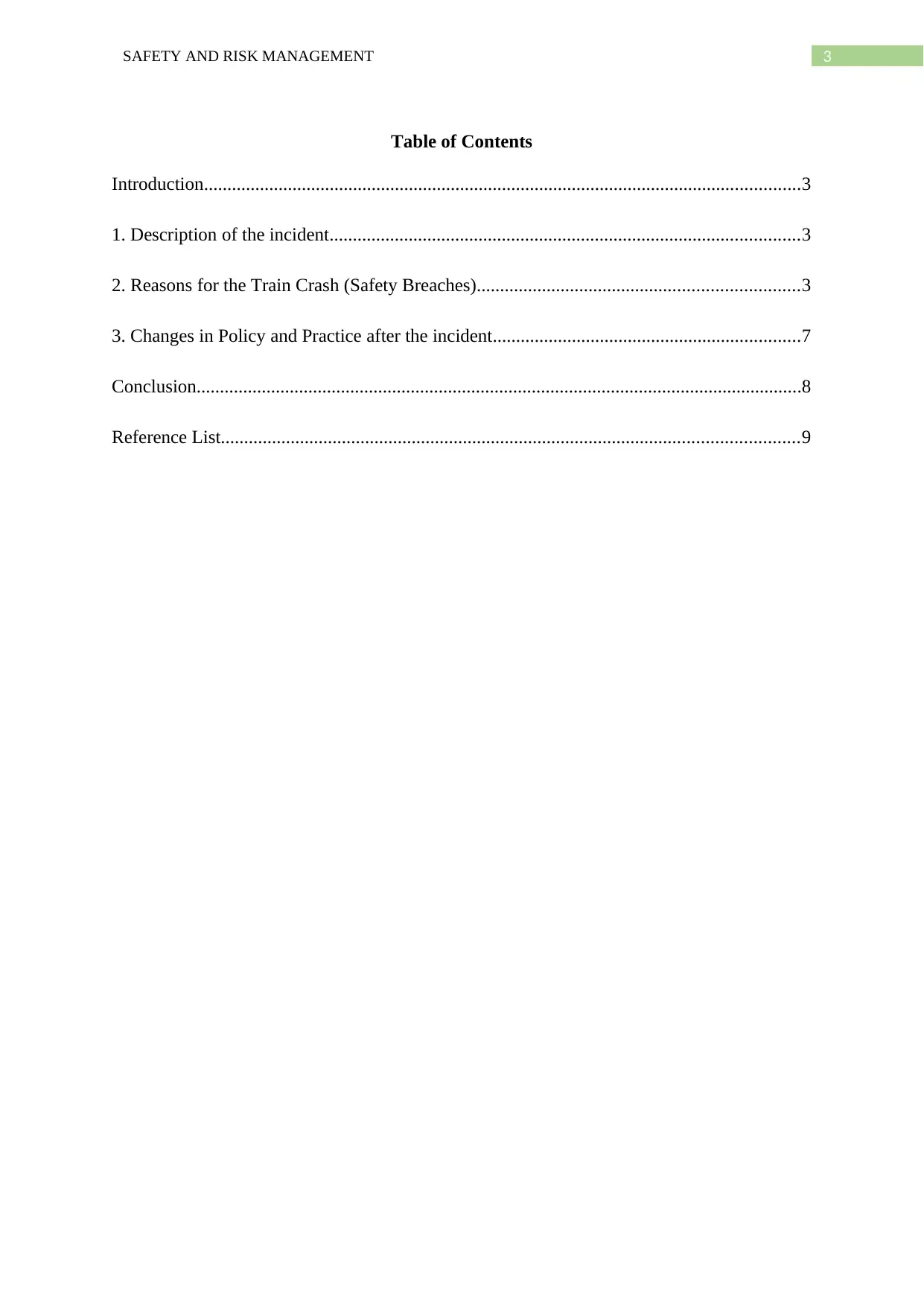
3SAFETY AND RISK MANAGEMENT
Table of Contents
Introduction................................................................................................................................3
1. Description of the incident.....................................................................................................3
2. Reasons for the Train Crash (Safety Breaches).....................................................................3
3. Changes in Policy and Practice after the incident..................................................................7
Conclusion..................................................................................................................................8
Reference List............................................................................................................................9
Table of Contents
Introduction................................................................................................................................3
1. Description of the incident.....................................................................................................3
2. Reasons for the Train Crash (Safety Breaches).....................................................................3
3. Changes in Policy and Practice after the incident..................................................................7
Conclusion..................................................................................................................................8
Reference List............................................................................................................................9
⊘ This is a preview!⊘
Do you want full access?
Subscribe today to unlock all pages.

Trusted by 1+ million students worldwide
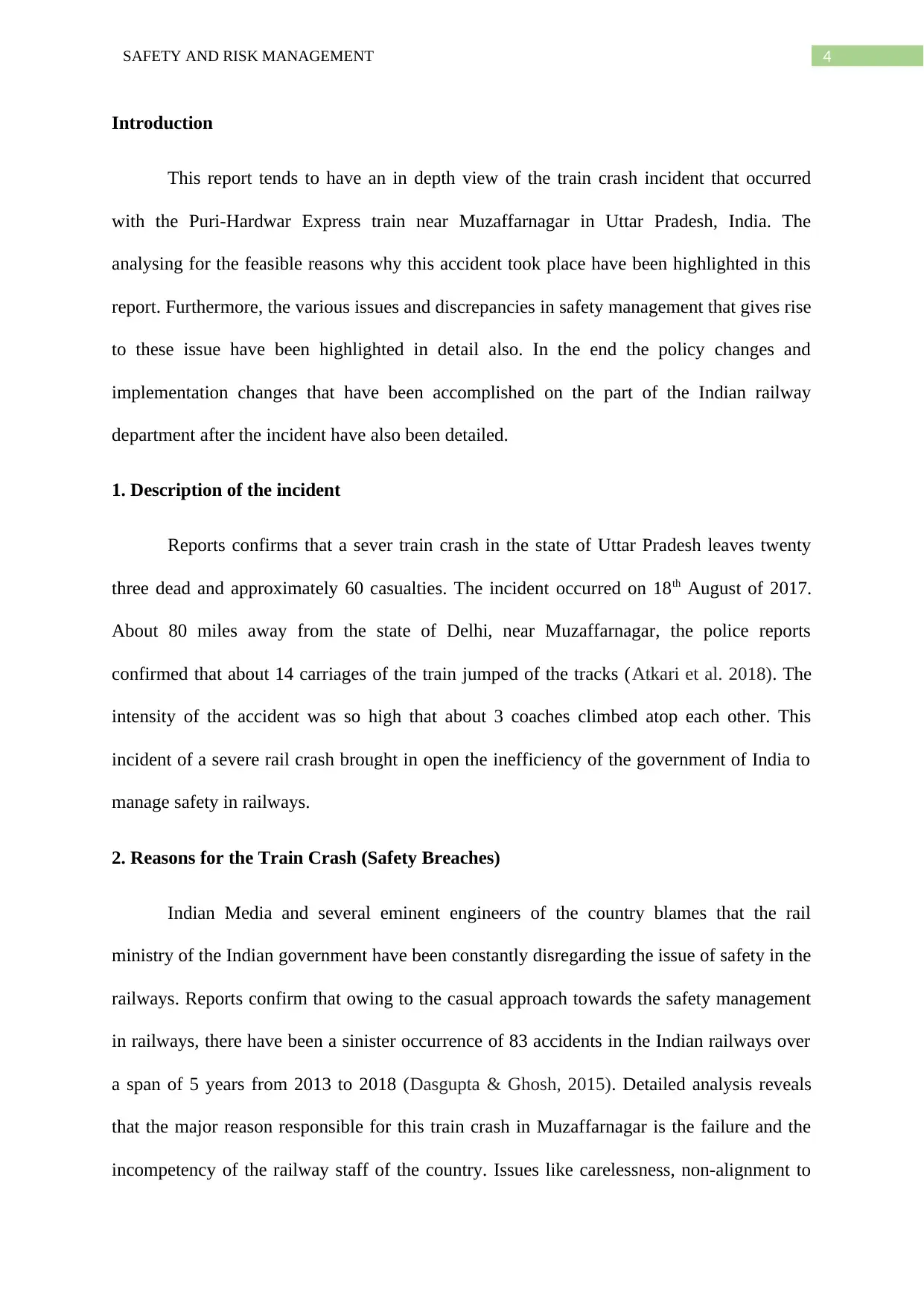
4SAFETY AND RISK MANAGEMENT
Introduction
This report tends to have an in depth view of the train crash incident that occurred
with the Puri-Hardwar Express train near Muzaffarnagar in Uttar Pradesh, India. The
analysing for the feasible reasons why this accident took place have been highlighted in this
report. Furthermore, the various issues and discrepancies in safety management that gives rise
to these issue have been highlighted in detail also. In the end the policy changes and
implementation changes that have been accomplished on the part of the Indian railway
department after the incident have also been detailed.
1. Description of the incident
Reports confirms that a sever train crash in the state of Uttar Pradesh leaves twenty
three dead and approximately 60 casualties. The incident occurred on 18th August of 2017.
About 80 miles away from the state of Delhi, near Muzaffarnagar, the police reports
confirmed that about 14 carriages of the train jumped of the tracks (Atkari et al. 2018). The
intensity of the accident was so high that about 3 coaches climbed atop each other. This
incident of a severe rail crash brought in open the inefficiency of the government of India to
manage safety in railways.
2. Reasons for the Train Crash (Safety Breaches)
Indian Media and several eminent engineers of the country blames that the rail
ministry of the Indian government have been constantly disregarding the issue of safety in the
railways. Reports confirm that owing to the casual approach towards the safety management
in railways, there have been a sinister occurrence of 83 accidents in the Indian railways over
a span of 5 years from 2013 to 2018 (Dasgupta & Ghosh, 2015). Detailed analysis reveals
that the major reason responsible for this train crash in Muzaffarnagar is the failure and the
incompetency of the railway staff of the country. Issues like carelessness, non-alignment to
Introduction
This report tends to have an in depth view of the train crash incident that occurred
with the Puri-Hardwar Express train near Muzaffarnagar in Uttar Pradesh, India. The
analysing for the feasible reasons why this accident took place have been highlighted in this
report. Furthermore, the various issues and discrepancies in safety management that gives rise
to these issue have been highlighted in detail also. In the end the policy changes and
implementation changes that have been accomplished on the part of the Indian railway
department after the incident have also been detailed.
1. Description of the incident
Reports confirms that a sever train crash in the state of Uttar Pradesh leaves twenty
three dead and approximately 60 casualties. The incident occurred on 18th August of 2017.
About 80 miles away from the state of Delhi, near Muzaffarnagar, the police reports
confirmed that about 14 carriages of the train jumped of the tracks (Atkari et al. 2018). The
intensity of the accident was so high that about 3 coaches climbed atop each other. This
incident of a severe rail crash brought in open the inefficiency of the government of India to
manage safety in railways.
2. Reasons for the Train Crash (Safety Breaches)
Indian Media and several eminent engineers of the country blames that the rail
ministry of the Indian government have been constantly disregarding the issue of safety in the
railways. Reports confirm that owing to the casual approach towards the safety management
in railways, there have been a sinister occurrence of 83 accidents in the Indian railways over
a span of 5 years from 2013 to 2018 (Dasgupta & Ghosh, 2015). Detailed analysis reveals
that the major reason responsible for this train crash in Muzaffarnagar is the failure and the
incompetency of the railway staff of the country. Issues like carelessness, non-alignment to
Paraphrase This Document
Need a fresh take? Get an instant paraphrase of this document with our AI Paraphraser
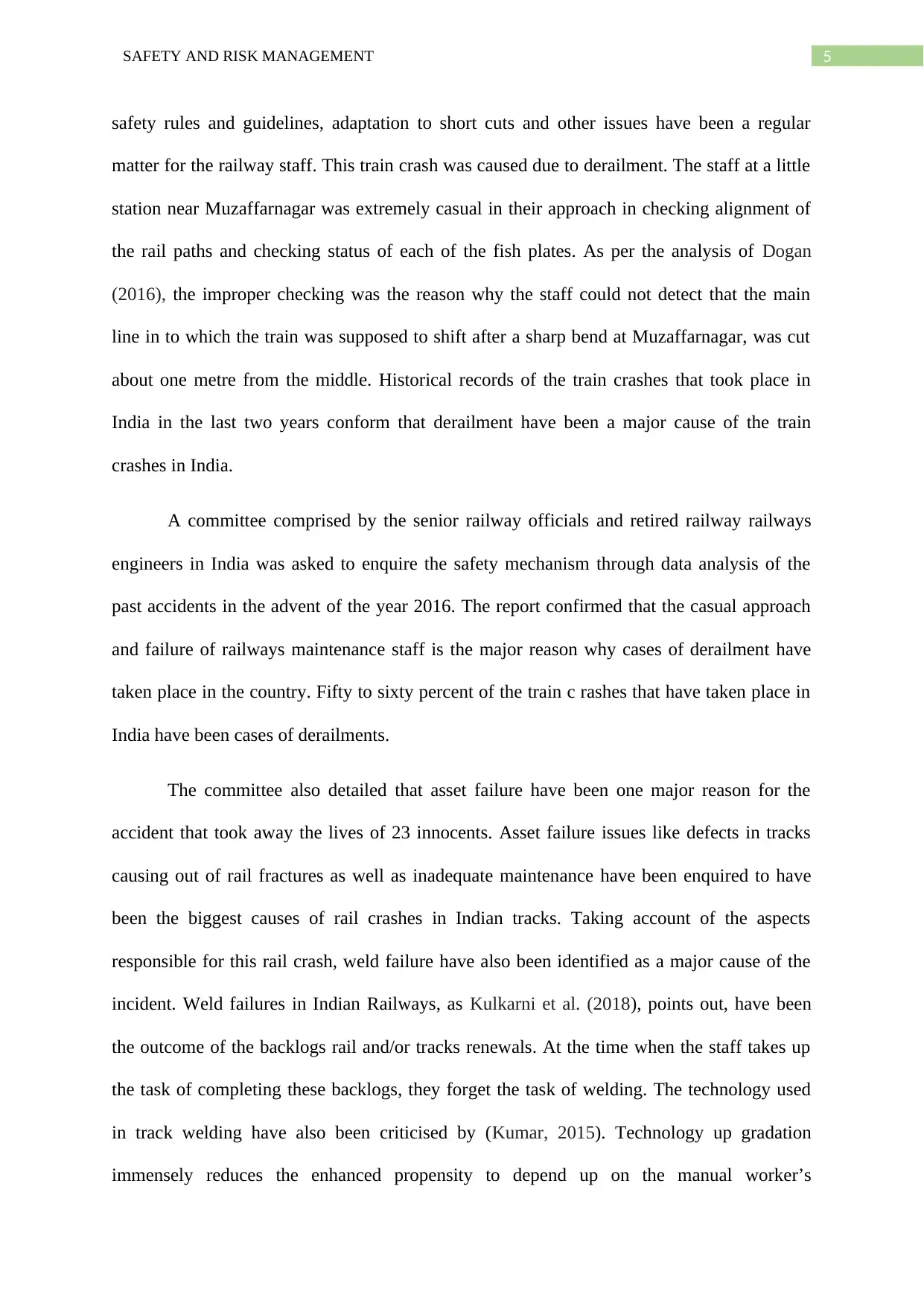
5SAFETY AND RISK MANAGEMENT
safety rules and guidelines, adaptation to short cuts and other issues have been a regular
matter for the railway staff. This train crash was caused due to derailment. The staff at a little
station near Muzaffarnagar was extremely casual in their approach in checking alignment of
the rail paths and checking status of each of the fish plates. As per the analysis of Dogan
(2016), the improper checking was the reason why the staff could not detect that the main
line in to which the train was supposed to shift after a sharp bend at Muzaffarnagar, was cut
about one metre from the middle. Historical records of the train crashes that took place in
India in the last two years conform that derailment have been a major cause of the train
crashes in India.
A committee comprised by the senior railway officials and retired railway railways
engineers in India was asked to enquire the safety mechanism through data analysis of the
past accidents in the advent of the year 2016. The report confirmed that the casual approach
and failure of railways maintenance staff is the major reason why cases of derailment have
taken place in the country. Fifty to sixty percent of the train c rashes that have taken place in
India have been cases of derailments.
The committee also detailed that asset failure have been one major reason for the
accident that took away the lives of 23 innocents. Asset failure issues like defects in tracks
causing out of rail fractures as well as inadequate maintenance have been enquired to have
been the biggest causes of rail crashes in Indian tracks. Taking account of the aspects
responsible for this rail crash, weld failure have also been identified as a major cause of the
incident. Weld failures in Indian Railways, as Kulkarni et al. (2018), points out, have been
the outcome of the backlogs rail and/or tracks renewals. At the time when the staff takes up
the task of completing these backlogs, they forget the task of welding. The technology used
in track welding have also been criticised by (Kumar, 2015). Technology up gradation
immensely reduces the enhanced propensity to depend up on the manual worker’s
safety rules and guidelines, adaptation to short cuts and other issues have been a regular
matter for the railway staff. This train crash was caused due to derailment. The staff at a little
station near Muzaffarnagar was extremely casual in their approach in checking alignment of
the rail paths and checking status of each of the fish plates. As per the analysis of Dogan
(2016), the improper checking was the reason why the staff could not detect that the main
line in to which the train was supposed to shift after a sharp bend at Muzaffarnagar, was cut
about one metre from the middle. Historical records of the train crashes that took place in
India in the last two years conform that derailment have been a major cause of the train
crashes in India.
A committee comprised by the senior railway officials and retired railway railways
engineers in India was asked to enquire the safety mechanism through data analysis of the
past accidents in the advent of the year 2016. The report confirmed that the casual approach
and failure of railways maintenance staff is the major reason why cases of derailment have
taken place in the country. Fifty to sixty percent of the train c rashes that have taken place in
India have been cases of derailments.
The committee also detailed that asset failure have been one major reason for the
accident that took away the lives of 23 innocents. Asset failure issues like defects in tracks
causing out of rail fractures as well as inadequate maintenance have been enquired to have
been the biggest causes of rail crashes in Indian tracks. Taking account of the aspects
responsible for this rail crash, weld failure have also been identified as a major cause of the
incident. Weld failures in Indian Railways, as Kulkarni et al. (2018), points out, have been
the outcome of the backlogs rail and/or tracks renewals. At the time when the staff takes up
the task of completing these backlogs, they forget the task of welding. The technology used
in track welding have also been criticised by (Kumar, 2015). Technology up gradation
immensely reduces the enhanced propensity to depend up on the manual worker’s
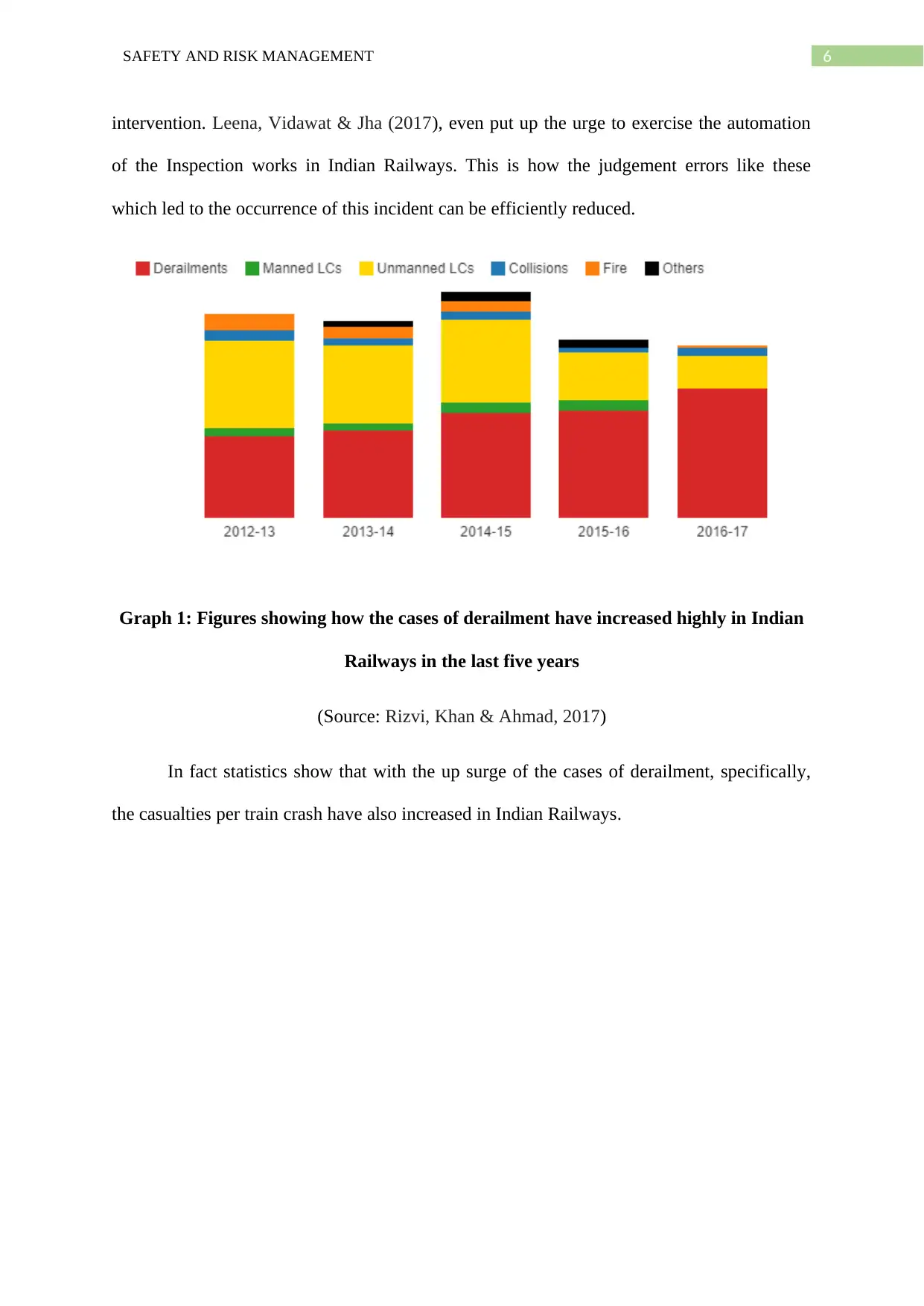
6SAFETY AND RISK MANAGEMENT
intervention. Leena, Vidawat & Jha (2017), even put up the urge to exercise the automation
of the Inspection works in Indian Railways. This is how the judgement errors like these
which led to the occurrence of this incident can be efficiently reduced.
Graph 1: Figures showing how the cases of derailment have increased highly in Indian
Railways in the last five years
(Source: Rizvi, Khan & Ahmad, 2017)
In fact statistics show that with the up surge of the cases of derailment, specifically,
the casualties per train crash have also increased in Indian Railways.
intervention. Leena, Vidawat & Jha (2017), even put up the urge to exercise the automation
of the Inspection works in Indian Railways. This is how the judgement errors like these
which led to the occurrence of this incident can be efficiently reduced.
Graph 1: Figures showing how the cases of derailment have increased highly in Indian
Railways in the last five years
(Source: Rizvi, Khan & Ahmad, 2017)
In fact statistics show that with the up surge of the cases of derailment, specifically,
the casualties per train crash have also increased in Indian Railways.
⊘ This is a preview!⊘
Do you want full access?
Subscribe today to unlock all pages.

Trusted by 1+ million students worldwide
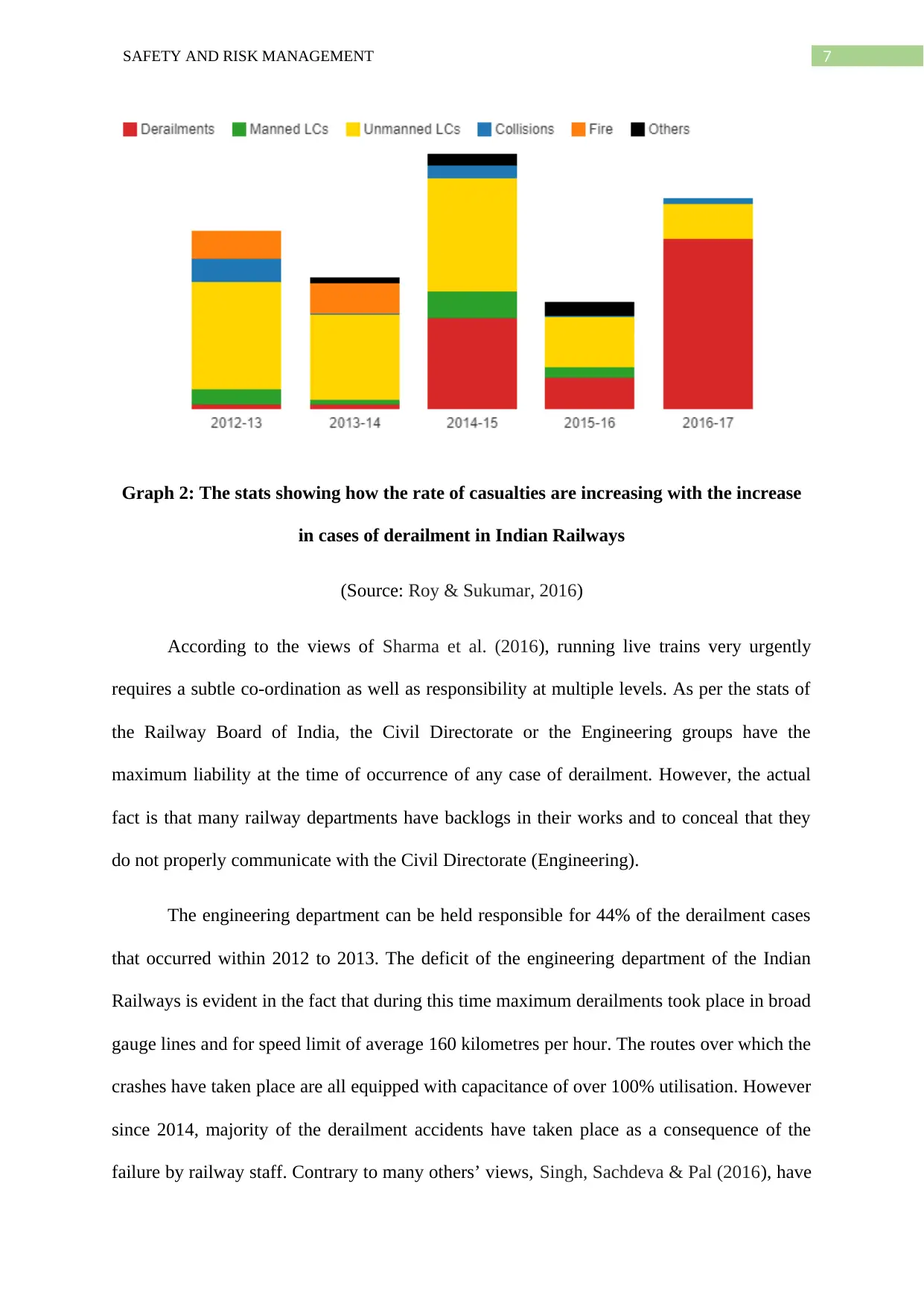
7SAFETY AND RISK MANAGEMENT
Graph 2: The stats showing how the rate of casualties are increasing with the increase
in cases of derailment in Indian Railways
(Source: Roy & Sukumar, 2016)
According to the views of Sharma et al. (2016), running live trains very urgently
requires a subtle co-ordination as well as responsibility at multiple levels. As per the stats of
the Railway Board of India, the Civil Directorate or the Engineering groups have the
maximum liability at the time of occurrence of any case of derailment. However, the actual
fact is that many railway departments have backlogs in their works and to conceal that they
do not properly communicate with the Civil Directorate (Engineering).
The engineering department can be held responsible for 44% of the derailment cases
that occurred within 2012 to 2013. The deficit of the engineering department of the Indian
Railways is evident in the fact that during this time maximum derailments took place in broad
gauge lines and for speed limit of average 160 kilometres per hour. The routes over which the
crashes have taken place are all equipped with capacitance of over 100% utilisation. However
since 2014, majority of the derailment accidents have taken place as a consequence of the
failure by railway staff. Contrary to many others’ views, Singh, Sachdeva & Pal (2016), have
Graph 2: The stats showing how the rate of casualties are increasing with the increase
in cases of derailment in Indian Railways
(Source: Roy & Sukumar, 2016)
According to the views of Sharma et al. (2016), running live trains very urgently
requires a subtle co-ordination as well as responsibility at multiple levels. As per the stats of
the Railway Board of India, the Civil Directorate or the Engineering groups have the
maximum liability at the time of occurrence of any case of derailment. However, the actual
fact is that many railway departments have backlogs in their works and to conceal that they
do not properly communicate with the Civil Directorate (Engineering).
The engineering department can be held responsible for 44% of the derailment cases
that occurred within 2012 to 2013. The deficit of the engineering department of the Indian
Railways is evident in the fact that during this time maximum derailments took place in broad
gauge lines and for speed limit of average 160 kilometres per hour. The routes over which the
crashes have taken place are all equipped with capacitance of over 100% utilisation. However
since 2014, majority of the derailment accidents have taken place as a consequence of the
failure by railway staff. Contrary to many others’ views, Singh, Sachdeva & Pal (2016), have
Paraphrase This Document
Need a fresh take? Get an instant paraphrase of this document with our AI Paraphraser
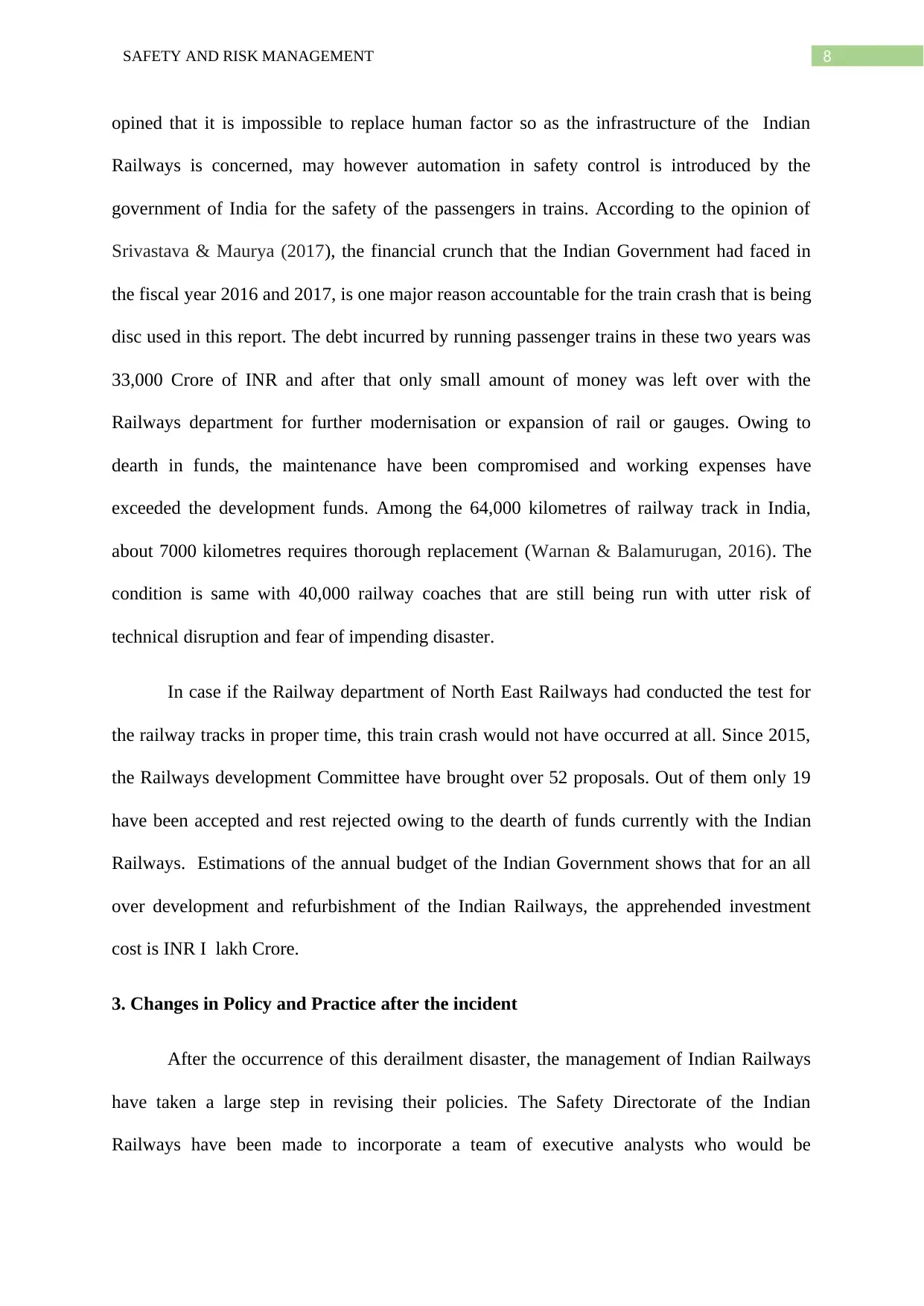
8SAFETY AND RISK MANAGEMENT
opined that it is impossible to replace human factor so as the infrastructure of the Indian
Railways is concerned, may however automation in safety control is introduced by the
government of India for the safety of the passengers in trains. According to the opinion of
Srivastava & Maurya (2017), the financial crunch that the Indian Government had faced in
the fiscal year 2016 and 2017, is one major reason accountable for the train crash that is being
disc used in this report. The debt incurred by running passenger trains in these two years was
33,000 Crore of INR and after that only small amount of money was left over with the
Railways department for further modernisation or expansion of rail or gauges. Owing to
dearth in funds, the maintenance have been compromised and working expenses have
exceeded the development funds. Among the 64,000 kilometres of railway track in India,
about 7000 kilometres requires thorough replacement (Warnan & Balamurugan, 2016). The
condition is same with 40,000 railway coaches that are still being run with utter risk of
technical disruption and fear of impending disaster.
In case if the Railway department of North East Railways had conducted the test for
the railway tracks in proper time, this train crash would not have occurred at all. Since 2015,
the Railways development Committee have brought over 52 proposals. Out of them only 19
have been accepted and rest rejected owing to the dearth of funds currently with the Indian
Railways. Estimations of the annual budget of the Indian Government shows that for an all
over development and refurbishment of the Indian Railways, the apprehended investment
cost is INR I lakh Crore.
3. Changes in Policy and Practice after the incident
After the occurrence of this derailment disaster, the management of Indian Railways
have taken a large step in revising their policies. The Safety Directorate of the Indian
Railways have been made to incorporate a team of executive analysts who would be
opined that it is impossible to replace human factor so as the infrastructure of the Indian
Railways is concerned, may however automation in safety control is introduced by the
government of India for the safety of the passengers in trains. According to the opinion of
Srivastava & Maurya (2017), the financial crunch that the Indian Government had faced in
the fiscal year 2016 and 2017, is one major reason accountable for the train crash that is being
disc used in this report. The debt incurred by running passenger trains in these two years was
33,000 Crore of INR and after that only small amount of money was left over with the
Railways department for further modernisation or expansion of rail or gauges. Owing to
dearth in funds, the maintenance have been compromised and working expenses have
exceeded the development funds. Among the 64,000 kilometres of railway track in India,
about 7000 kilometres requires thorough replacement (Warnan & Balamurugan, 2016). The
condition is same with 40,000 railway coaches that are still being run with utter risk of
technical disruption and fear of impending disaster.
In case if the Railway department of North East Railways had conducted the test for
the railway tracks in proper time, this train crash would not have occurred at all. Since 2015,
the Railways development Committee have brought over 52 proposals. Out of them only 19
have been accepted and rest rejected owing to the dearth of funds currently with the Indian
Railways. Estimations of the annual budget of the Indian Government shows that for an all
over development and refurbishment of the Indian Railways, the apprehended investment
cost is INR I lakh Crore.
3. Changes in Policy and Practice after the incident
After the occurrence of this derailment disaster, the management of Indian Railways
have taken a large step in revising their policies. The Safety Directorate of the Indian
Railways have been made to incorporate a team of executive analysts who would be
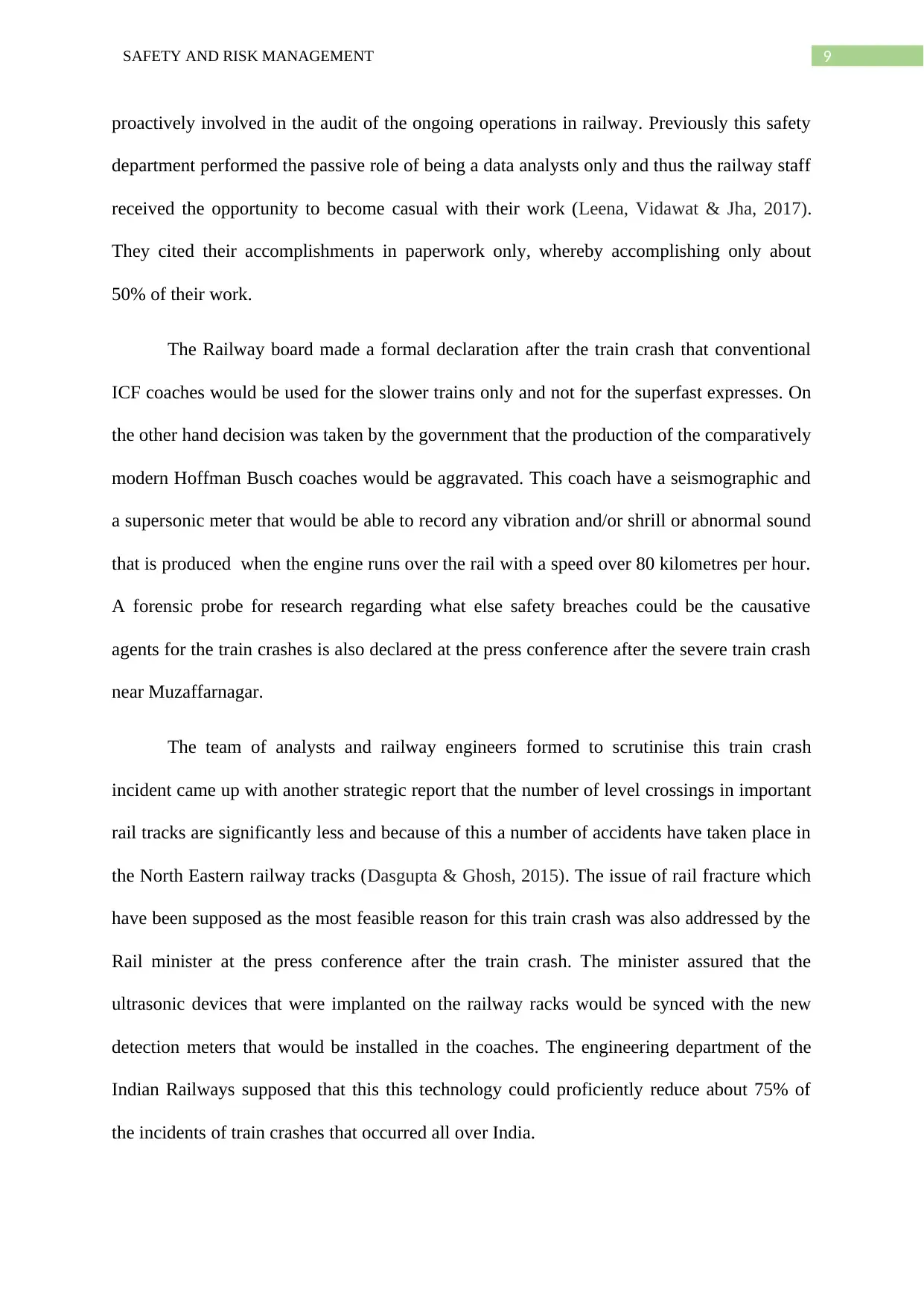
9SAFETY AND RISK MANAGEMENT
proactively involved in the audit of the ongoing operations in railway. Previously this safety
department performed the passive role of being a data analysts only and thus the railway staff
received the opportunity to become casual with their work (Leena, Vidawat & Jha, 2017).
They cited their accomplishments in paperwork only, whereby accomplishing only about
50% of their work.
The Railway board made a formal declaration after the train crash that conventional
ICF coaches would be used for the slower trains only and not for the superfast expresses. On
the other hand decision was taken by the government that the production of the comparatively
modern Hoffman Busch coaches would be aggravated. This coach have a seismographic and
a supersonic meter that would be able to record any vibration and/or shrill or abnormal sound
that is produced when the engine runs over the rail with a speed over 80 kilometres per hour.
A forensic probe for research regarding what else safety breaches could be the causative
agents for the train crashes is also declared at the press conference after the severe train crash
near Muzaffarnagar.
The team of analysts and railway engineers formed to scrutinise this train crash
incident came up with another strategic report that the number of level crossings in important
rail tracks are significantly less and because of this a number of accidents have taken place in
the North Eastern railway tracks (Dasgupta & Ghosh, 2015). The issue of rail fracture which
have been supposed as the most feasible reason for this train crash was also addressed by the
Rail minister at the press conference after the train crash. The minister assured that the
ultrasonic devices that were implanted on the railway racks would be synced with the new
detection meters that would be installed in the coaches. The engineering department of the
Indian Railways supposed that this this technology could proficiently reduce about 75% of
the incidents of train crashes that occurred all over India.
proactively involved in the audit of the ongoing operations in railway. Previously this safety
department performed the passive role of being a data analysts only and thus the railway staff
received the opportunity to become casual with their work (Leena, Vidawat & Jha, 2017).
They cited their accomplishments in paperwork only, whereby accomplishing only about
50% of their work.
The Railway board made a formal declaration after the train crash that conventional
ICF coaches would be used for the slower trains only and not for the superfast expresses. On
the other hand decision was taken by the government that the production of the comparatively
modern Hoffman Busch coaches would be aggravated. This coach have a seismographic and
a supersonic meter that would be able to record any vibration and/or shrill or abnormal sound
that is produced when the engine runs over the rail with a speed over 80 kilometres per hour.
A forensic probe for research regarding what else safety breaches could be the causative
agents for the train crashes is also declared at the press conference after the severe train crash
near Muzaffarnagar.
The team of analysts and railway engineers formed to scrutinise this train crash
incident came up with another strategic report that the number of level crossings in important
rail tracks are significantly less and because of this a number of accidents have taken place in
the North Eastern railway tracks (Dasgupta & Ghosh, 2015). The issue of rail fracture which
have been supposed as the most feasible reason for this train crash was also addressed by the
Rail minister at the press conference after the train crash. The minister assured that the
ultrasonic devices that were implanted on the railway racks would be synced with the new
detection meters that would be installed in the coaches. The engineering department of the
Indian Railways supposed that this this technology could proficiently reduce about 75% of
the incidents of train crashes that occurred all over India.
⊘ This is a preview!⊘
Do you want full access?
Subscribe today to unlock all pages.

Trusted by 1+ million students worldwide
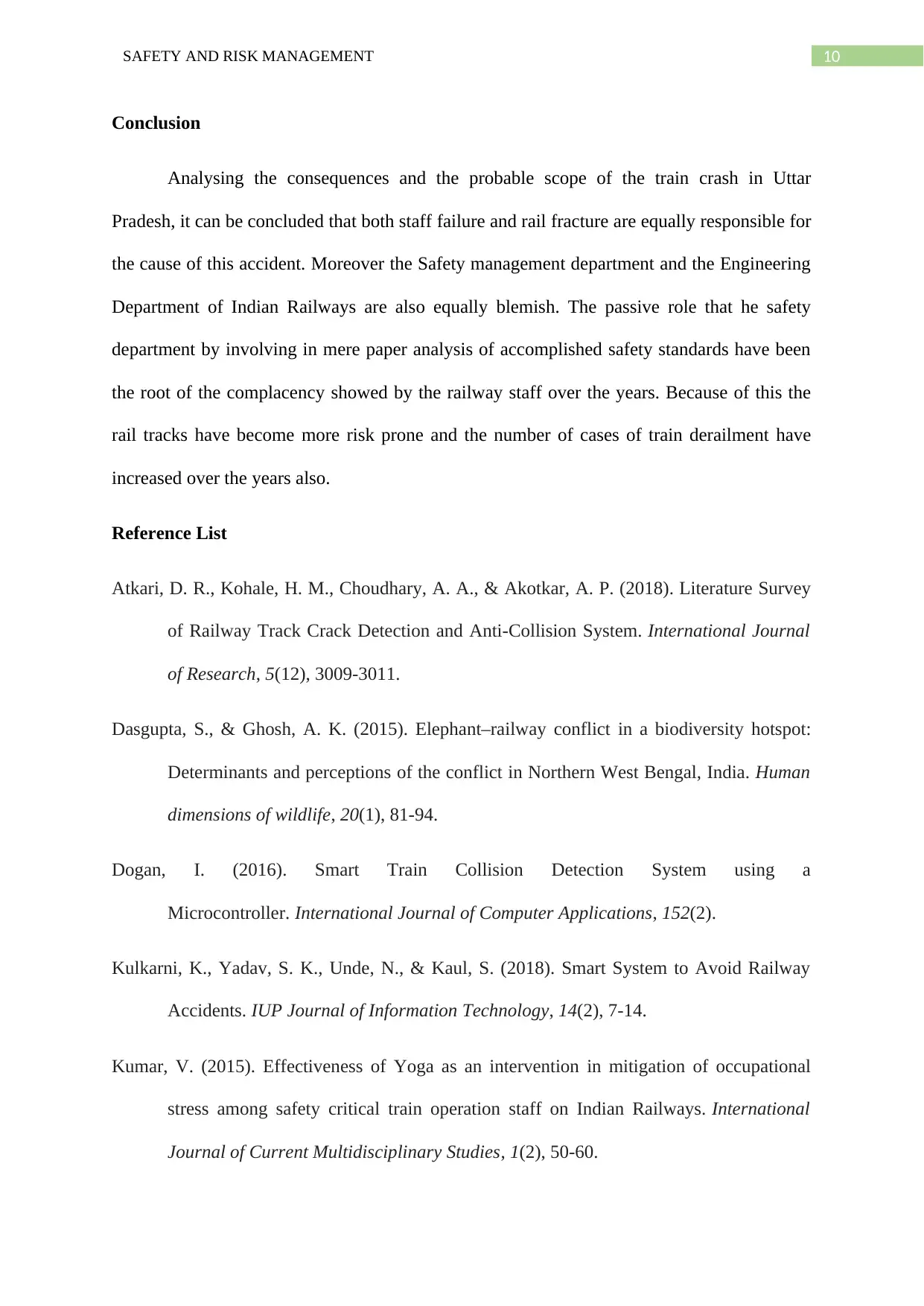
10SAFETY AND RISK MANAGEMENT
Conclusion
Analysing the consequences and the probable scope of the train crash in Uttar
Pradesh, it can be concluded that both staff failure and rail fracture are equally responsible for
the cause of this accident. Moreover the Safety management department and the Engineering
Department of Indian Railways are also equally blemish. The passive role that he safety
department by involving in mere paper analysis of accomplished safety standards have been
the root of the complacency showed by the railway staff over the years. Because of this the
rail tracks have become more risk prone and the number of cases of train derailment have
increased over the years also.
Reference List
Atkari, D. R., Kohale, H. M., Choudhary, A. A., & Akotkar, A. P. (2018). Literature Survey
of Railway Track Crack Detection and Anti-Collision System. International Journal
of Research, 5(12), 3009-3011.
Dasgupta, S., & Ghosh, A. K. (2015). Elephant–railway conflict in a biodiversity hotspot:
Determinants and perceptions of the conflict in Northern West Bengal, India. Human
dimensions of wildlife, 20(1), 81-94.
Dogan, I. (2016). Smart Train Collision Detection System using a
Microcontroller. International Journal of Computer Applications, 152(2).
Kulkarni, K., Yadav, S. K., Unde, N., & Kaul, S. (2018). Smart System to Avoid Railway
Accidents. IUP Journal of Information Technology, 14(2), 7-14.
Kumar, V. (2015). Effectiveness of Yoga as an intervention in mitigation of occupational
stress among safety critical train operation staff on Indian Railways. International
Journal of Current Multidisciplinary Studies, 1(2), 50-60.
Conclusion
Analysing the consequences and the probable scope of the train crash in Uttar
Pradesh, it can be concluded that both staff failure and rail fracture are equally responsible for
the cause of this accident. Moreover the Safety management department and the Engineering
Department of Indian Railways are also equally blemish. The passive role that he safety
department by involving in mere paper analysis of accomplished safety standards have been
the root of the complacency showed by the railway staff over the years. Because of this the
rail tracks have become more risk prone and the number of cases of train derailment have
increased over the years also.
Reference List
Atkari, D. R., Kohale, H. M., Choudhary, A. A., & Akotkar, A. P. (2018). Literature Survey
of Railway Track Crack Detection and Anti-Collision System. International Journal
of Research, 5(12), 3009-3011.
Dasgupta, S., & Ghosh, A. K. (2015). Elephant–railway conflict in a biodiversity hotspot:
Determinants and perceptions of the conflict in Northern West Bengal, India. Human
dimensions of wildlife, 20(1), 81-94.
Dogan, I. (2016). Smart Train Collision Detection System using a
Microcontroller. International Journal of Computer Applications, 152(2).
Kulkarni, K., Yadav, S. K., Unde, N., & Kaul, S. (2018). Smart System to Avoid Railway
Accidents. IUP Journal of Information Technology, 14(2), 7-14.
Kumar, V. (2015). Effectiveness of Yoga as an intervention in mitigation of occupational
stress among safety critical train operation staff on Indian Railways. International
Journal of Current Multidisciplinary Studies, 1(2), 50-60.
Paraphrase This Document
Need a fresh take? Get an instant paraphrase of this document with our AI Paraphraser
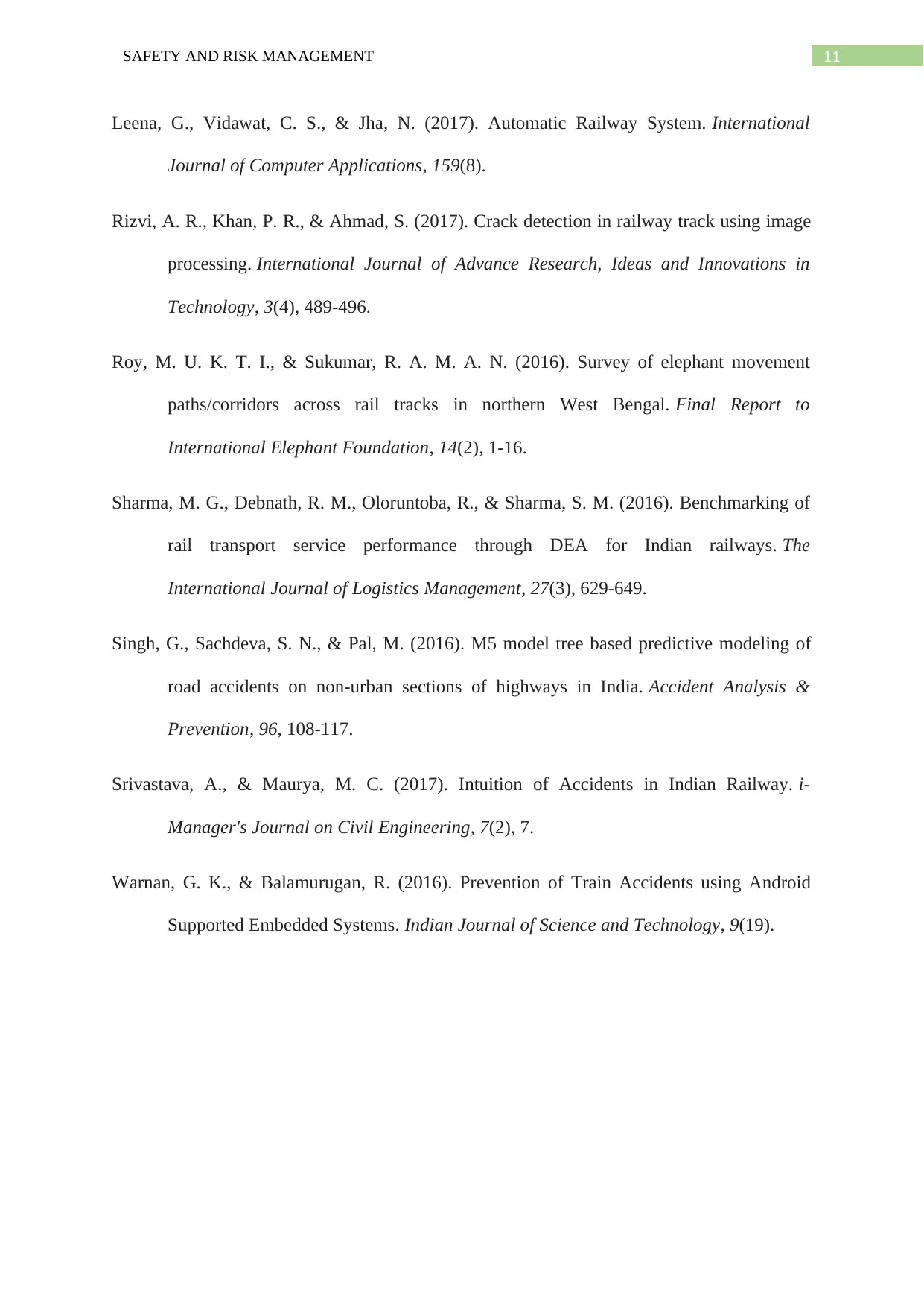
11SAFETY AND RISK MANAGEMENT
Leena, G., Vidawat, C. S., & Jha, N. (2017). Automatic Railway System. International
Journal of Computer Applications, 159(8).
Rizvi, A. R., Khan, P. R., & Ahmad, S. (2017). Crack detection in railway track using image
processing. International Journal of Advance Research, Ideas and Innovations in
Technology, 3(4), 489-496.
Roy, M. U. K. T. I., & Sukumar, R. A. M. A. N. (2016). Survey of elephant movement
paths/corridors across rail tracks in northern West Bengal. Final Report to
International Elephant Foundation, 14(2), 1-16.
Sharma, M. G., Debnath, R. M., Oloruntoba, R., & Sharma, S. M. (2016). Benchmarking of
rail transport service performance through DEA for Indian railways. The
International Journal of Logistics Management, 27(3), 629-649.
Singh, G., Sachdeva, S. N., & Pal, M. (2016). M5 model tree based predictive modeling of
road accidents on non-urban sections of highways in India. Accident Analysis &
Prevention, 96, 108-117.
Srivastava, A., & Maurya, M. C. (2017). Intuition of Accidents in Indian Railway. i-
Manager's Journal on Civil Engineering, 7(2), 7.
Warnan, G. K., & Balamurugan, R. (2016). Prevention of Train Accidents using Android
Supported Embedded Systems. Indian Journal of Science and Technology, 9(19).
Leena, G., Vidawat, C. S., & Jha, N. (2017). Automatic Railway System. International
Journal of Computer Applications, 159(8).
Rizvi, A. R., Khan, P. R., & Ahmad, S. (2017). Crack detection in railway track using image
processing. International Journal of Advance Research, Ideas and Innovations in
Technology, 3(4), 489-496.
Roy, M. U. K. T. I., & Sukumar, R. A. M. A. N. (2016). Survey of elephant movement
paths/corridors across rail tracks in northern West Bengal. Final Report to
International Elephant Foundation, 14(2), 1-16.
Sharma, M. G., Debnath, R. M., Oloruntoba, R., & Sharma, S. M. (2016). Benchmarking of
rail transport service performance through DEA for Indian railways. The
International Journal of Logistics Management, 27(3), 629-649.
Singh, G., Sachdeva, S. N., & Pal, M. (2016). M5 model tree based predictive modeling of
road accidents on non-urban sections of highways in India. Accident Analysis &
Prevention, 96, 108-117.
Srivastava, A., & Maurya, M. C. (2017). Intuition of Accidents in Indian Railway. i-
Manager's Journal on Civil Engineering, 7(2), 7.
Warnan, G. K., & Balamurugan, R. (2016). Prevention of Train Accidents using Android
Supported Embedded Systems. Indian Journal of Science and Technology, 9(19).
1 out of 11
Related Documents
Your All-in-One AI-Powered Toolkit for Academic Success.
+13062052269
info@desklib.com
Available 24*7 on WhatsApp / Email
![[object Object]](/_next/static/media/star-bottom.7253800d.svg)
Unlock your academic potential
Copyright © 2020–2025 A2Z Services. All Rights Reserved. Developed and managed by ZUCOL.





